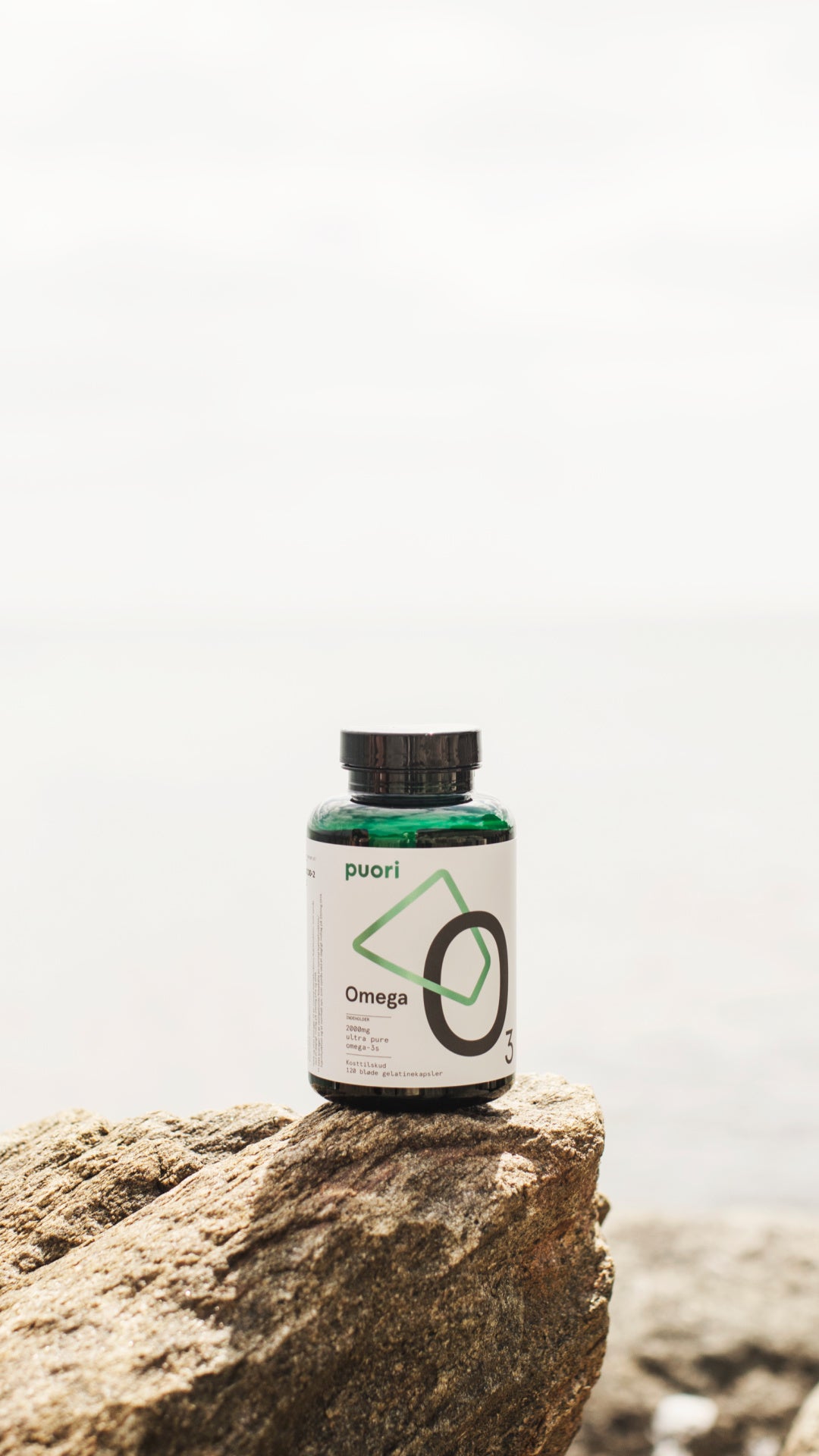
Guide to Puori O3
Puori O3 is a unique fish oil formulation created exclusively by Puori. The product is sourced from small, wild-caught anchovies. Puori delivers one of the most concentrated natural triglyceride (nTG) fish oils in the world and delivers a guaranteed minimum of 74% natural triglyceride omega-3 (2000mg) containing 1250mg of EPA, 500mg of DHA and 250g of other omega-3 fatty acids in just 3 capsules. All Puori O3 batches undergo rigorous examinations and testing before and after encapsulation/packaging. These guidelines ensure pharmaceutical quality compliance. Puori O3 is awarded 5 stars from IFOS for passing the strictest industry standards for purity, freshness and potency.
Health benefits
– Reduces the risk of cardiovascular disease: Omega-3 has beneficial effects on cardiovascular disease in patients with pre-existing cardiovascular disease as well as in healthy individuals. (4) In addition, supplementation with EPA and DHA forms of omega-3 reduces total mortality, cardiovascular mortality, and cardiovascular morbidity. (5)
– Maintains brain function: DHA is a major structural component of the human brain. Cognitive decline in the elderly can be reduced with omega-3 supplementation, by inhibiting the reduction in brain glucose uptake that occurs with age. (6)
– Maintains eye function: Low levels of DHA and EPA have been associated with eye diseases such as retinopathies and age-related macular degeneration. (7)
– Improves recovery: Omega-3 fatty acids have been shown to augment blood flow to muscles during exercise, decreasing muscle soreness by up to 35% and reduce swelling. (1)
– Inflammation: Omega-3 fatty acids reduce the cellular inflammatory response by reducing inflammatory mediators such as cytokines. (2)
– Improves joint range of motion: Omega-3 fats have been shown to increase joint range of motion. (3)
Recommended dosage
The general recommendation is to aim for around 2-4 grams (2000-4000mg) of EPA and DHA combined per day, preferably from natural sources such as wild fish such as salmon, trout or sardines. If you have limited access to these, you can use supplements to get to the ideal dose.
If you’re a competitive athlete, a higher daily dose of between 5-7grams per day may be recommended to prevent inflammation, enhance recovery and improve performance.
Each Puori O3 capsule contains a minimum of 74% natural triglycerides and a total serving of 3 capsules will provide 2000mg of omega-3, comprised of 1250mg EPA, 500mg DHA and 250mg other forms of omega-3.
We recommend taking a minimum of 3 Puori O3 capsules per day, depending on your levels of physical activity and your consumption of oily fish.
Intake of omega-6 fatty acids from your diet (found in nuts, vegetable oils and seeds) can have an impact on omega-3 uptake. Supplementing with omega-3 fatty acids results in a more favorable omega-6: omega-3 fatty acid ratio. (9)
Puori O3 should be taken for a minimum of three months for maximum health benefits, including reduced plasma triglycerides. (10)
Omega-3 supplementation can have an anticoagulant (blood-thinning) effect. Care should be taken if you are already taking aspirin, warfarin or other blood-thinning medications.
How to take Puori O3
– Fish oil supplements should always be taken with food, to improve the fatty acid profile of the meal. A meal containing healthy fats will also increase absorption. (11)
– Consuming Puori O3 after exercise may be beneficial due to the anti-inflammatory effects of fish oil.
– Take with Puori D3 for maximum benefit.
How to store Puori O3
Keep Puori O3 in a cool, dark place (preferably in the fridge). Fish oil reacts to heat and light, which can cause oxidation and turn it rancid. Ensure a stable environment for Puori O3, and avoid exposure to temperature fluctuations.
Alternative sources of Omega-3
– Salmon: Wild salmon contains around 1.3g of Omega-3 per 100g and farmed salmon contains 0.6g of Omega-3 per 100g.
– Eggs: Eggs contain around 0.8g of omega-3 per 100g, however, it is predominantly in the form of α-Linolenic acid (ALA), which has extremely poor bioavailability compared with EPA and DHA. Research shows that approximately 5% of ALA converts to EPA, and just 1% converts to DHA.
– Walnuts: Walnuts contain 10.4g of omega-3 per 100g, however, it is in the form of α-Linolenic acid (ALA), which has extremely poor bioavailability compared with EPA and DHA.
References:
1. Jeff S. Volek, Ph.D. (2012). Why athletes need omega-3s. Available: http://www.nutritionexpress.com/showarticle.aspx?articleid=1633. Last accessed 25th June 2014.
2. Kang, Jing X., and Karsten H. Weylandt. “Modulation of inflammatory cytokines by omega-3 fatty acids.” Lipids in Health and Disease. Springer Netherlands, 2008. 133-143.
3. Tartibian, Bakhtiar, Behzad Hajizadeh Maleki, and Asghar Abbasi. “The effects of ingestion of omega-3 fatty acids on perceived pain and external symptoms of delayed onset muscle soreness in untrained men.” Clinical Journal of Sport Medicine 19.2 (2009): 115-119.
4. Kris-Etherton, Penny M., William S. Harris, and Lawrence J. Appel. “Fish consumption, fish oil, omega-3 fatty acids, and cardiovascular disease.” circulation 106.21 (2002): 2747-2757.
5. von Schacky, Clemens. “The role of omega-3 fatty acids in cardiovascular disease.” Current atherosclerosis reports 5.2 (2003): 139-145.
6. Freemantle, Erika, et al. “Omega-3 fatty acids, energy substrates, and brain function during aging.” Prostaglandins, leukotrienes and essential fatty acids 75.3 (2006): 213-220.
7. Connor, Kip M., et al. “Increased dietary intake of ω-3-polyunsaturated fatty acids reduces pathological retinal angiogenesis.” Nature medicine 13.7 (2007): 868-873.
8. Aktas, Huseyin, and Jose A. Halperin. “Translational regulation of gene expression by ω-3 fatty acids.” The Journal of nutrition 134.9 (2004): 2487S-2491S.
9. Simopoulos, Artemis P. “The importance of the omega-6/omega-3 fatty acid ratio in cardiovascular disease and other chronic diseases.” Experimental Biology and Medicine 233.6 (2008): 674-688.
10. Goh, Y. K., et al. “Effect of w3 fatty acid on plasma lipids, cholesterol and lipoprotein fatty acid content in NIDDM patients.” Diabetologia 40.1 (1997): 45-52.
11. Lawson, Larry D., and Bronwyn G. Hughes. “Absorption of eicosapentaenoic acid and docosahexaenoic acid from fish oil triacylglycerols or fish oil ethyl esters co-ingested with a high-fat meal.” Biochemical and biophysical research communications 156.2 (1988): 960-963.